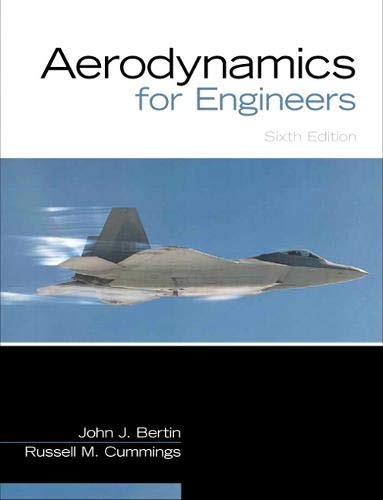

Most ebook files are in PDF format, so you can easily read them using various software such as Foxit Reader or directly on the Google Chrome browser.
Some ebook files are released by publishers in other formats such as .awz, .mobi, .epub, .fb2, etc. You may need to install specific software to read these formats on mobile/PC, such as Calibre.
Please read the tutorial at this link: https://ebookbell.com/faq
We offer FREE conversion to the popular formats you request; however, this may take some time. Therefore, right after payment, please email us, and we will try to provide the service as quickly as possible.
For some exceptional file formats or broken links (if any), please refrain from opening any disputes. Instead, email us first, and we will try to assist within a maximum of 6 hours.
EbookBell Team

4.4
62 reviews
ISBN 10: 1009098624
ISBN 13: 9781009098625
Author: John J Bertin, Russell M Cummings
Chapter 1 Why Study Aerodynamics?
1.1 Aerodynamics and the Energy-Maneuverability Technique
1.2 Solving for the Aerothermodynamic Parameters
1.3 Description of an Airplane
1.4 Summary
Problems
References
Chapter 2 Fundamentals of Fluid Mechanics
2.1 Introduction to Fluid Dynamics
2.2 Conservation of Mass
2.3 Conservation of Linear Momentum
2.4 Applications to Constant-Property Flows
2.5 Reynolds Number and Mach Number as Similarity Parameters
2.6 Concept of the Boundary Layer
2.7 Conservation of Energy
2.8 First Law of Thermodynamics
2.9 Derivation of the Energy Equation
2.10 Summary
Problems
References
Chapter 3 Dynamics of An Incompressible,Inviscid Flow Field
3.1 Inviscid Flows
3.2 Bernoulli’s Equation
3.3 Use of Bernoulli’s Equation to Determine Airspeed
3.4 The Pressure Coefficient
3.5 Circulation
3.6 Irrotational Flow
3.7 Kelvin’s Theorem
3.8 Incompressible, Irrotational Flow and the Velocity Potential
3.9 Stream Function in a Two-Dimensional, Incompressible Flow
3.10 Relation between Streamlines and Equipotential Lines
3.11 Superposition of Flows
3.12 Elementary Flows
3.13 Adding Elementary Flows to Describe Flow Around a Cylinder
3.14 Lift and Drag Coefficients as Dimensionless Flow-Field Parameters
3.15 Flow Around a Cylinder with Circulation
3.16 Source Density Distribution on the Body Surface
3.17 Incompressible, Axisymmetric Flow
3.18 Summary
Problems
References
Chapter 4 Viscous Boundary Layers
4.1 Equations Governing the Boundary Layer for a Steady, Two-Dimensional, Incompressible Flow
4.2 Boundary Conditions
4.3 Incompressible, Laminar Boundary Layer
4.4 Boundary-Layer Transition
4.5 Incompressible, Turbulent Boundary Layer
4.6 Eddy Viscosity and Mixing Length Concepts
4.7 Integral Equations for a Flat-Plate Boundary Layer
4.8 Thermal Boundary Layer for Constant-Property Flows
4.9 Summary
Problems
References
Chapter 5 Characteristic Paramaeters For Airfoil and Wing Aerodynamics
5.1 Characterization of Aerodynamic Forces and Moments
5.2 Airfoil Geometry Parameters
5.3 Wing-Geometry Parameters
5.4 Aerodynamic Force and Moment Coefficients
5.5 Wings of Finite Span
Problems
References
Chapter 6 Incompressible Flows Around Airfoils of Infinite Span
6.1 General Comments
6.2 Circulation and the Generation of Lift
6.3 General Thin-Airfoil Theory
6.4 Thin, Flat-Plate Airfoil (Symmetric Airfoil)
6.5 Thin, Cambered Airfoil
6.6 Laminar-Flow Airfoils
6.7 High-Lift Airfoil Sections
6.8 Multielement Airfoil Sections for Generating High Lift
6.9 High-Lift Military Airfoils
Problems
References
Chapter 7 Incompressible Flow About Wings of Finite Span
7.1 General Comments
7.2 Vortex System
7.3 Lifting-Line Theory for Unswept Wings
7.4 Panel Methods
7.5 Vortex Lattice Method
7.6 Factors Affecting Drag Due-to-Lift at Subsonic Speeds
7.7 Delta Wings
7.8 Leading-Edge Extensions
7.9 Asymmetric Loads on the Fuselage at High Angles of Attack
7.10 Flow Fields for Aircraft at High Angles of Attack
7.11 Unmanned Air Vehicle Wings
7.12 Summary
Problems
References
Chapter 8 Dynamics of A Compressible Flow Field
8.1 Thermodynamic Concepts
8.2 Adiabatic Flow in a Variable-Area Streamtube
8.3 Isentropic Flow in a Variable-Area Streamtube
8.4 Converging-diverging Nozzles
8.5 Characteristic Equations and Prandtl-Meyer Flows
8.6 Shock Waves
8.7 Viscous Boundary Layer
8.8 Shock-Wave/Boundary-Layer Interactions
8.9 Shock/Shock Interactions
8.10 The Role of Experiments for Generating Information Defining the Flow Field
8.11 Comments About the Scaling/Correction Process(es) for Relatively Clean Cruise Configurations
8.12 Summary
Problems
References
Chapter 9 Compressible, Subsonic Flows And Transonic Flows
9.1 Compressible, Subsonic Flow
9.2 Transonic Flow Past Unswept Airfoils
9.3 Wave Drag Reduction by Design
9.4 Swept Wings at Transonic Speeds
9.5 Transonic Aircraft
9.6 Summary
Problems
References
Chapter 10 Two-Dimensional, Supersonic Flows Around Thin Airfoils
10.1 Linear Theory
10.2 Second-Order Theory (Busemann’s Theory)
10.3 Shock-Expansion Technique
10.4 Summary
Problems
References
Chapter 11 Supersonic Flows Over Wings and Airplane Configurations
11.1 General Remarks About Lift and Drag
11.2 General Remarks About Supersonic Wings
11.3 Governing Equation and Boundary Conditions
11.4 Consequences of Linearity
11.5 Solution Methods
11.6 Conical-Flow Method
11.7 Singularity-Distribution Method
11.8 Design Considerations for Supersonic Aircraft
11.9 Some Comments About the Design of the SST and of the HSCT
11.10 Slender Body Theory
11.11 Base Drag
11.12 Aerodynamic Interaction
11.13 Aerodynamic Analysis for Complete Configurations in a Supersonic Free Stream
11.14 Summary
Problems
References
Chapter 12 Hypersonic Flows
12.1 The Five Distinguishing Characteristics
12.2 Newtonian Flow Model
12.3 Stagnation Region Flow-Field Properties
12.4 Modified Newtonian Flow
12.5 High L/D Hypersonic Configurations—Waveriders
12.6 Aerodynamic Heating
12.7 A Hypersonic Cruiser for the Twenty-First Century?
12.8 Importance of Interrelating CFD, Ground-Test Data, and Flight-Test Data
12.9 Boundary-Layer-Transition Methodology
12.10 Summary
Problems
References
Chapter 13 Aerodynamic Design Considerations
13.1 High-Lift Configurations
13.2 Circulation Control Wing
13.3 Design Considerations for Tactical Military Aircraft
13.4 Drag Reduction
13.5 Development of an Airframe Modification to Improve the Mission Effectiveness of an Existing Air
13.6 Considerations for Wing/Canard, Wing/Tail, and Tailless Configurations
13.7 Comments on the F-15 Design
13.8 The Design of the F-22
13.9 The Design of the F-35
13.10 Summary
Problems
References
Chapter 14 Tools For Defining The Aerodynamic Environment
14.1 Computational Tools
14.2 Establishing the Credibility of CFD Simulations
14.3 Ground-Based Test Programs
14.4 Flight-Test Programs
14.5 Integration of Experimental and Computational Tools: The Aerodynamic Design Philosophy
14.6 Summary
References
aerodynamics for engineers
bertin aerodynamics for engineers pdf
borrow aerodynamics for engineers
aerodynamics for engineers 6th edition pdf
aerodynamics for engineers solution manual
aerodynamics for engineers 7th edition
Tags: John J Bertin, Russell M Cummings, Aerodynamics, engineers